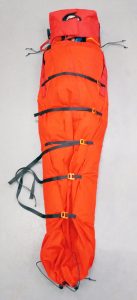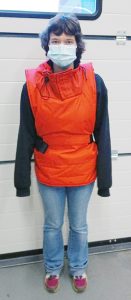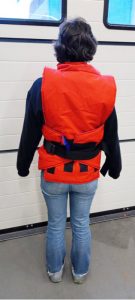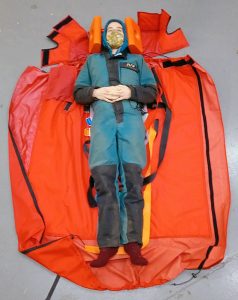Developing the next generation of Casbag
The cave environment in the UK is a hostile one: cold water, strong draughts and an ambient air temperature of 8-12°C mean hypothermia is an ever-present danger for those requiring rescue. There is a well described increase in mortality from hypothermia associated with major trauma. It is also a risk to rescue team members, particularly those involved in less physically active elements of rescues – for example manning underground communication stations. Over the years there has been significant progress in preventing and managing hypothermia, from the fabrics used in caving clothes, through the development of casbags and the Little Dragon, to the widespread use of Bivi shelters.
The most recent caving casbag was produced after collaboration between BCRC, the University of Leeds and Aiguille Alpine, with the finished item distributed to teams in 2007.
Early in 2020, a small team of keen volunteers started looking at developing a new generation of casbag, utilising advances in materials that have occurred over the past 15 years. Led by Ian Peachey (Upper Wharfdale Fell Rescue Association) and Jim Davis (Cave Rescue Organisation), the initial work was to review the process undertaken in the development of the 2007 casbag, and look holistically for areas that could be improved.
This initial investigation identified several key points:
- While the 2007 casualty bag is thermally effective, the main areas of complaint were weight, portability (especially in wet environments) and the cut and sizing which integrated poorly with larger casualties and bulky splints.
- Speed with which insulation reaches the casualty is critical.
- Head blocks are now the preferred C-spine management option and the new bag should integrate well with these, as well as the new Slix stretcher spinal immobilization system.
- There are limited options for warming cold but mobile casualties who do not require stretcher evacuation or who cannot be evacuated in a full stretcher because of the nature of the passage.
From this analysis the team decided to focus on reducing weight and pack size as well as improving the design of the bag to be as flexible for use in as many scenarios as possible. The project has branched out to include the design of a cas jacket for use with mobile casualties and to give a highly portable insulation option for use in searches. The team is also working on developing battery powered heat pad systems and ways to integrate these with our designs so that the new equipment will be compatible with modern equipment over the next 20 years. A key concept of the project was to design a complete hypothermia management system that would fit in a standard caving bag and weigh under 4kg.
The Casualty Jacket
Similar in style to a belay jacket, it is designed to be put on over the cavers oversuit. It is intended as a compact, lightweight jacket that can be carried on searches when the casualty’s condition is unknown. It can be worn by a mobile casualty, and potentially be used for a stretcher casualty, especially if it is known that they will need to be removed from the main casbag to pass a restriction.
It can also be used by team members, especially if they are in a non-mobile role. Easy to put on, remove and repack, it could later be used by a casualty if required.
Technical details
Hydrophobic synthetic insulation using 133g/m2 Climashield apex insulation.
6 OZ PU coated nylon shell fabric – waterproof and robust enough to be caved in confidently.
2 OZ PU coated nylon liner fabric creating vapour barrier with oversuit beneath.
Open-sided design allowing for wide variety in casualty size and application over arm injuries.
Wide collar allows application over helmet.
Pockets to contain heat packs (internally) and battery packs (externally) allowing battery change without removing garment.
Velcro fastening, with additional belt in case of Velcro failure due to muddy environments.
Total weight including heat pack – 600g, with battery an additional 132g.
Ian, in conjunction with Beth Knight (Derbyshire CRO) have produced a few development models, which have been subjected to some field testing. Ten jackets, funded by BCRC, are currently being produced and distributed to teams for final testing and feedback. The intention is that by Summer 2021 the design will have been finalised and teams will be able to order jackets.
The Casualty Bag
The new design, loosely based on the Aiguille Alpine lightweight MR bag, wraps around the casualty, is velcroed shut to prevent drafts, and tightened to fit the casualty with a series of straps. There is a drawstring at the foot end to pull the bottom of the bag shut, leaving a small hole for drainage of any water (a real issue in cave rescues). If the casualty is extremely tall (>6ft 6) then their feet may protrude from the end of the bag, but the drawstring can be tightened around their legs instead. It has been designed to integrate with the new Slix Stretchers used by many cave rescue teams, as well as head blocks and spinal splints. The previous bag had a fleece liner which was warm when dry, but which easily became waterlogged, making the bag a lot heavier and less insulating. This bag is made of the same material as the casualty jacket, providing both insulation and a vapour barrier.
Technical details

Hydrophobic synthetic insulation using 133g/m2 Climashield apex insulation.
Currently trialling both 6 OZ PU coated and 4 OZ Neoprene coated nylon shell fabric – waterproof and robust enough to be cave-proof, especially when protected by a stretcher.
2 OZ PU coated nylon liner fabric creating vapour barrier with oversuit beneath, and preventing water ingress into the insulation.
Detachable hood which integrates with head blocks and allows access to spinal splint attachment points.
Arm zips, allowing casualty to have arms either in or out of the bag.
Wrap design allows adjustment for all lengths and breadths of casualty.
Velcro fastening allows easy access to casualty for safety ropes or clinical care, while preventing drafts.
Velcro pads inside allow attachment of heat packs to prevent migration during rescue.
Total weight, including hood – 1,880g.
Ian and Beth are in the process of making some ‘final’ prototypes, which will then go to teams for testing. We hope that a final version will be decided on by late Summer 2021, and can then start being produced for teams.
Electrical Heat Pads
Chemical heat pads have been used for many years, and can generate a significant amount of heat while being robust and easy to transport. However, the heat generation can be erratic, and once the pad is exhausted it cannot be reused on the same rescue. Cave rescues can easily take many hours, and so they may need to be replaced. There is also no way of monitoring or regulating their output. There are now a number of electrical packs on the market which are being looked at. These have a number of appealing features. Light, flexible and low profile, they can be applied to almost any part of a casualty without affecting immobilisation. The power packs can be kept outside the casualty bag, and so can be changed without needing to unwrap the casualty. The output can also be regulated to provide different levels of heating.
Ali Garman (South and Mid Wales Cave Rescue Team) and Ian have carried out a series of tests of different options. Commercially available options appear effective, with a battery life of between 2.5 and 7.5 hours depending on output level. The intention is to develop our own system using non-proprietary and easily available components, which will allow us to create a rugged system, with the ability to easily swap out any faulty elements.
This work is in a much earlier stage of development, but holds a great deal of promise for the future. The Casualty jacket and Casbag will be designed so that future battery-powered heat packs can be easily integrated.
The developments were shown to BCRC teams at a Zoom event on 5th December 2020. It should be noted that development is ongoing, and by the time of publishing there is likely to have been significant further progress.
All of this work has been undertaken voluntarily, and I am hugely grateful to Ian, Ali, and Beth who have devoted a lot of time to this. The intention is to develop something of use to all teams, so if you are interested in finding out more, or in helping with the development, please contact either medical@caverescue.org.uk or casbag@caverescue.org.uk
Dr Brendan Sloan, BCRC Medical Officer,
Derbyshire Cave Rescue Organisation/South & Mid Wales Cave Rescue Team



